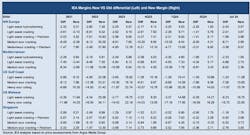IEA revises refining margins calculation methodologies
The International Energy Agency (IEA) recently updated refining margin methodology to better reflect changing refinery crude slates, energy-related costs, updated yield assumptions and product prices reflecting recent trends.
“We have also restated the indicator margins back to 2010. In combination, these changes better capture the marginal economics of crude processing within the current market, with the re-routing of Russian crude to Asia, the increasing importance of export pricing to US Gulf Coast refineries and the impact on processing rates that differing utility costs can have,” IEA said.
Overall, margin assessments are revised lower for most complexities and regions, in large part due to the increased cost structure, according to IEA. However, for some regions, e.g. the US Gulf Coast and the US Midcontinent, changes to assumed pricing points also impact the overall calculation.
Margins are calculated for 5 key refining hubs, namely the Mediterranean, Northwest Europe, Singapore, the US Gulf Coast, and the US Midcontinent. The crude considered is based on the typical regional slate, accessibility, API and sulphur content. Margins are calculated for different complexities including hydroskimming, catalytic cracking, coking and petrochemicals integration.
For the different configurations, gross refinery margins are calculated with each yield multiplied by the relevant daily product price from which the crude price and the cost freight is subtracted.
“In a departure from the previous methodology, we now include regional utility costs, including natural gas, refinery fuel gas, LPG, fuel oil, electricity, and petroleum coke. The utilities annual consumption data for OECD countries is derived from the IEA’s World Energy Statistics, which are used to estimate average energy consumed per barrel of crude processed,” IEA said.
As detailed data on energy consumption is unavailable for some regions, IEA has used Korean data on energy consumption as a proxy for Singapore. For various complexities within a specific region, IEA has adjusted published data to reflect differing energy intensities.
“While a better reflection of refinery profitability, the new margins remain indicative as they do not include the full spectrum of energy costs (e.g. purchased steam, etc.), as well as other non-energy variable costs (such as chemicals or catalysts), capital expenditures or labor costs,” IEA mentioned.
Changes to Northwest Europe and Mediterranean margins are driven mainly by increased LPG (60%) and natural gas (30%) costs, whereas in Singapore, higher electricity costs account for roughly 50% of the change, while LPG and natural gas account for 25% and 20%, respectively. The loss of Russian Urals crude for seaborne imports to the European Union has redrawn regional and global crude flows. Consequently, IEA has shifted Mediterranean sour crude cracking margins to use Iraqi Basrah Medium from the start of 2022.
The reassessed margins for Northwest Europe, the Mediterranean and Singapore now reflect a margin environment close to breakeven levels consistent with run cuts for 2020 and 2021.
Northwest Europe, the Mediterranean and Singapore see the largest impact to margins due to high energy costs. Conversely, US margins benefit from comparatively cheap energy costs, but have been more heavily impacted by changes to product yield assumptions and pricing assessments, according to IEA.
